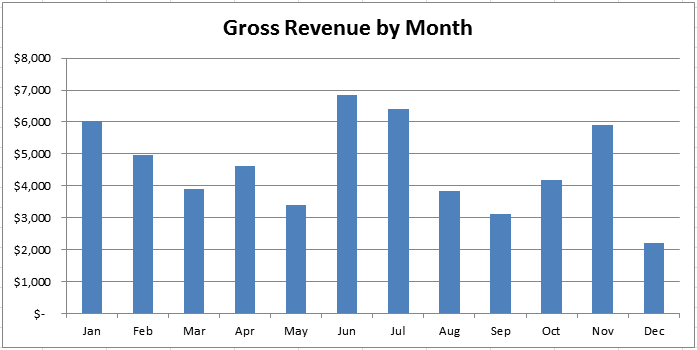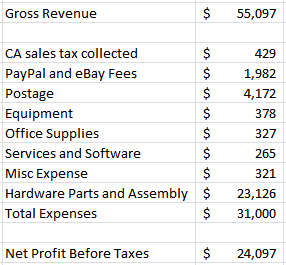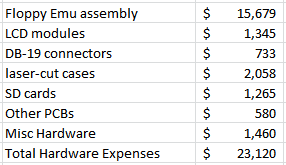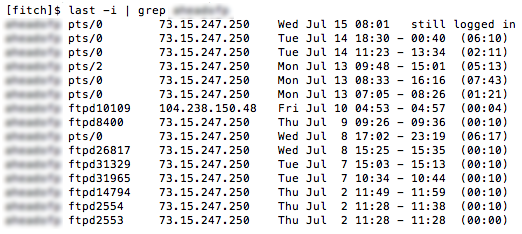Archive for the 'Business' Category
Crikey! USPS International Shipping Costs

Running a mail-order business gives me many opportunities to think about the cost of shipping. I’ve just made a change to the BMOW store that enables small, lightweight packages sent within the USA to be shipped by USPS First Class Mail rather than Priority Mail, cutting the shipping cost in half. Woohoo! But that’s about all the help I’m going to get from the US Postal Service, and I’m slowly realizing that USPS has some of the least competitive postage rates in the world.
A typical BMOW package weighs about 10 ounces, or 283 grams. To mail that package to the UK, Australia, Germany, or other countries where customers may live costs me $22.75 in postage via “First-Class Package International Service”, which is the cheapest option available. That’s a significant amount of money. If my store sells a 10 ounce item that costs about $20, it’s unlikely anyone outside the USA will be buying it, unless they relish paying more for postage than for the item itself.
I decided to compare the cost of international shipping for a comparable 10 ounce / 283 gram package, sent from a few other major countries:
| County | Cost for shipping 283g International Package |
Cost in US Dollars |
| USA | USD $22.75 | $22.75 |
| Canada | CAD $19.39 | $14.90 |
| UK | £14.90 | $21.20 |
| Australia | AUD $14.10 | $10.83 |
| Germany | €3.70 | $4.22 |
The US has the most expensive international postage rates of any of these countries. (But at least this gave me a chance to learn how to type £ and € on a US keyboard, where those symbols don’t appear.)
The real anomaly in international shipping is China. Sending a package from the USA to China costs me the same as to any other country. But sending a package from China to the USA appears to be nearly free. Take one look at any of the many “free shipping” deals available from Chinese sellers on Aliexpress, eBay, or similar sites, and you’ll wonder if reality has been suspended. And it’s not that they’re absorbing the cost of shipping into the item price. Take this LED voltage meter for example: it costs $0.78, is available in single quantities, and ships free to the USA. Granted the delivery time stinks (up to 40 days), but at that price few people are complaining. How are postage prices like that possible? I can’t even ship within the USA for that price, let alone internationally.
I’m always looking for the most economical way to get BMOW packages to customers. I only wish USPS could be more help!
Read 17 comments and join the conversationNew Project Ideas

It’s high time for a new project here at BMOW. These days I spend so much time on Floppy Emu, it’s hard to squeeze in anything else! A new project would help stir things up, and get the creative juices flowing. Here are some ideas I’ve been kicking around:
Electric Scribbling Machine – I described this one in yesterday’s post. It’s a tripod with colored pens for legs, and a motor that makes it move, drawing tracks on the paper beneath it as it goes. Yesterday’s post described a “vibrabot” design using an offset weight on the motor shaft, which randomly jiggles the machine and creates interesting erratic drawings. I’ve since been working on an alternate design in which the motor is used directly as one of the legs, which spins the whole machine in rapid circles, and creates elegant looping drawings somewhat reminiscent of a Spirograph.
USB Keyboard/Mouse Adapter for Vintage Macintosh – Classic Macintosh computers like the Mac SE and Mac II series used input devices based on ADB – the Apple Desktop Bus. The Mac Plus and Mac 128K/512K were more primitive, and used custom protocols for keyboard and mouse rather than any bus-based system. Both systems are fairly well documented, and I have some experience with them already. Using a modern microcontroller, it shouldn’t be too difficult to build an adapter that functions as a USB host for a modern keyboard and mouse, and translates the input data to ADB or the Mac Plus protocol.
Weather Logging Station – A few years ago I designed the Backwoods Logger, an ultra-tiny portable weather station. I envisioned it mainly as a graphing altimeter for people going on mountain hikes. After many discussions with interested people, it became clear that most people didn’t care about portability, or about having graphing functions or even a screen. What they wanted was a stationary module that could take regular temperature, pressure, and maybe humidity readings, and save a history of weeks or months of data. There are already a few designs like this, but maybe they’re too intimidating or their feature set isn’t quite right, because I still get occasional emails from people asking for something like this.
Nibbler Kit – Nibbler is a 4-bit CPU that I designed entirely using basic 7400-series logic elements. It was a one-off project for my own entertainment. William Buchholz later designed a nice Nibbler PCB for his hacker group, which got me thinking that something more polished would be nice. My web stats say the Nibbler pages are some of the most popular content on this site, so maybe there would be enough interest to justify a Nibbler kit? My only fear in offering a kit for something this complex is the potential support headaches. It might make more sense to offer finished Nibblers instead of kits, though that would take some of the fun out of it.
Electric Bow Tie 2.0 – As with the Backwoods Logger, I think I misjudged popular interest when I designed the Electric Bow Tie Kit. It’s fun to have neckwear that blinks and beeps, but mostly people don’t seem interested in assembling a kit – they just want something kitschy they can wear to a special event and get some laughs. I can say from personal experience that the blinking effect is fun, but the beeping effect starts to grate on your sanity after about 60 seconds. Electric Bow Tie 2.0 would probably drop the sound effects, but add many more LEDs controlled by a microcontroller, enabling all kinds of entertaining and annoying patterns like chase lights and starbursts. I’d also try to replace the 9V battery with one or two smaller CR2032 batteries to reduce weight.
Read 17 comments and join the conversationA New BMOW Storefront!

At last, BMOW is moving into the modern world with a new online storefront! As I mentioned in the Profit and Loss discussion a couple of weeks ago, the old solution of PayPal payment buttons and order tracking left much to be desired. The new storefront isn’t anything fancy, but it’s still a tremendous leap forward in terms of ease of use for me, and is also far better looking for customers.
You can browse the new store using the “BMOW Store” link at the upper right, and it’s fully functional and ready for purchases. For the time being, the “add to cart” buttons on project pages like Floppy Emu’s will continue to point to the old PayPal payment buttons. This provides an easy back-up solution in case anything goes wrong with the new system. Visitors using the BMOW Store link will make purchases through the new system, while those using purchase links on the BMOW project pages will continue to use the old system for now.
WooCommerce and Friends
After looking at many different e-commerce and shopping cart solutions, and installing and uninstalling Zen Cart, I finally settled on using WooCommerce. WooCommerce is a popular e-commerce platform that’s implemented as a WordPress plugin. The basic package is free, and the developers earn their income by selling a variety of add-ons and themes. As I discovered, it’s quite easy to set up a functional and attractive storefront in just a few hours. In order to minimize the risk of conflicts with my existing, heavy-customized WordPress install, I created an entirely new WordPress installation in a subdirectory of the BMOW site, used exclusively for the WooCommerce store.
I’m still using PayPal for payment processing, but the method is now PayPal Express instead of the clumsy PayPal payment buttons. The shopping cart functionality is implemented entirely on the BMOW site, within WooCommerce. When a shopper is ready to checkout, he’ll be redirected to a PayPal page, where he can enter a credit card number or his PayPal account credentials to authorize the purchase amount. He’ll then be redirected back to the BMOW site for a final review, at which point he may cancel or submit the order. Using this method, I avoid needing to ever directly handle sensitive payment info like credit card numbers. But customers still complete their transaction experiences on my site, where I can show them a thank you page, and maintain purchase statistics.
A few additional WooCommerce-related plugins proved handy:
- PayPal for WooCommerce – Enables use of PayPal Express functionality, and tighter integration with PayPal
- WooCommerce Weight Based Shipping – Charges different shipping amounts depending on the calculated total weight of items, destination country, and shipping method
- Storefront Site Logo – The default theme inexplicably lacked a way to add a logo to the store’s header
All of these plugins were free.
Cleanup
The only major concern I have isn’t a technical problem, but a design issue. With the introduction of a storefront, all of my creations now have product pages, in addition to the project pages that already existed (and that formerly doubled as product pages). This will be a source of confusion. For example, which page should be considered “the” ROM-inator page: the pre-existing ROM-inator project page or the new ROM-inator product page? Which one should a reviewer link to, or a potential buyer look to for details? Which do I want to appear first in the Google search results for “Mac ROM-inator”?
This may seem like a minor issue, but I’ve spent significant amounts of time thinking about it. I definitely want to avoid a situation where the mind-share for each of my inventions is semi-randomly split between two different web pages, with duplicated information. I looked for examples of how other sites addressed this problem, but couldn’t find any similar examples. My current approach is to keep the project page as the “official” page, with the product page having a much shorter description focused on actual purchase details, with several links back to the project page for further reading. This hopefully makes it clear which page is the main one, but at the expense of removing information from the very place in the store that would-be buyers need it in order to make a buying decision. So it may actually cost me sales. I’ll evaluate how this works for a while, and consider making the product page be the main one if necessary.
Happy shopping!
Read 3 comments and join the conversationWordPress, https, and Canonical URLs

About a week ago, I added an SSL certificate to the BMOW web site, in preparation for some improved shopping cart features. With an SSL certificate signed by a certificate authority (free from Let’s Encrypt), the site can serve pages using the encrypted https protocol as well as the standard non-encrypted http. Pages encrypted with https will show a padlock icon or something similar in the address bar of most web browsers, and are normally used for handling sensitive content like payment info for a web store. My plan was to continue serving the existing blog pages using http, and use https for the new shopping cart pages. But it’s technically possible to serve any page from the site using https – try it! Just manually edit the URL of this post in your address bar, and change http to https.
The main blog pages aren’t designed to be served with https, however, and they contain embedded non-secure content like images and comment forms that use the http protocol. If you view this post as https, it will work, but your browser will probably display a warning about insecure content. If you try to post a comment, you’ll see a warning about a non-secure form, and if you persist in posting the comment you’ll see an error 403: forbidden message.
Since nobody ever visits the BMOW site using https, I thought those security warning didn’t matter, until I discovered that Google has started replacing all of the BMOW links in its search results with https versions of those same links. Someone who searches Google for “KiCad vs Eagle” might see a result with an https link to my post on that topic. Following the link, they’ll get a bunch of security warnings from their browser. And after commenting on the post, they’ll get the dreaded error 403. Oops.
I learned that Google prefers to index pages as https rather than http, if it discovers that a web server supports both. After doing more research I considered a few paths out of this mess:
- Go full blown https everywhere on the site. Fix images, comment forms, and other content that use http.
- Redirect https requests to http versions of the same URL.
- Use canonical URLs to instruct search engines to index the http versions of pages, not https.
Switching everything to https would be lots of work, and wasn’t the end result I wanted anyway. Redirecting all https requests to http would probably be OK, but seems a little bit drastic, and I’d need to carve out exceptions for the shopping cart and admin pages.
Canonical URLs
Canonical URLs are a nice feature, and I decided to use them to solve this problem. In the header section of any HTML document, you can include a link like this one:
<link rel="canonical" href="http://www.example.com/mypage/" />
and search engines will index the page as http://www.example.com/mypage/, regardless of whether they reached the page as
http://www.example.com/mypage/ https://www.example.com/mypage/ https://www.example.com/mypage/?q=vegemite
WordPress automatically adds canonical URLs to some pages, but not all, so I installed the Yoast SEO plugin to gain more control over canonical URL generation. Yoast added the canonical URLs as expected, but not in the way I needed. If I visited a page on the site using http, then Yoast would generate a canonical URL link beginning with http://. But if I visited a page on the site using https, Yoast would generate a canonical URL link beginning with https://, which was exactly what I didn’t want. I was finally able to force canonical URLs to always start with http:// by inserting this code snippet into my WordPress install’s functions.php:
function design_canonical() {
global $post;
if(isset($_SERVER['HTTPS']) && $_SERVER['HTTPS'] == "on") {
$find = 'https://www.exampledomain.com';
$replace = '';
$theurl = str_replace($find,$replace,get_permalink($post->ID));
return site_url( $theurl , 'http' );
} else {
// Leave blank and Yoast SEO will use default canonical for posts/pages
}
}
add_filter( 'wpseo_canonical', 'design_canonical' );
Fixed?
This should be all that’s needed to make Google, Bing, and other search engines use http for indexing all my content. It may take a few days for the Google index to be updated with the new links, but eventually everything will be http. And that should be enough to prevent visitors from accidentally viewing the site content as https, right? Well, maybe not. I had forgotten about the existence of browser plugins like HTTPS Everywhere that attempt to force use https wherever they can. Even if Google’s no longer sending traffic to https versions of my pages, then, other sources of https traffic still exist. And those visitors will have all the security warning and error problems I described.
I’m scratching my head, wondering how to proceed. Redirect all https traffic to http, as I’d originally considered? Or leave everything as is, and let HTTPS Everywhere visitors deal with the problems that extension creates? Maybe there’s another simpler solution. It all makes me appreciate how complex the job of a web site admin can really be.
Read 12 comments and join the conversationKit Biz Profit and Loss

Have you ever wondered what life is like in the “kit biz”, with a part-time business selling electronic gizmos to hobbyists? Maybe you’ve thought about selling one of your own creations, or were just curious if it’s possible to make any money this way. In the spirit of helping the hobbyist community, I’m sharing the 2015 BMOW profit and loss breakdown here. My hope is that others might provide some helpful insights, or learn something that can help their own efforts. Normally I would keep this type of information private, but I decided there’s no harm in sharing, and more knowledge can only help.
BMOW began as a place to document my personal electronics projects and musings, and remains primarily an electronics blog. But along the way, it accidentally grew into a small business too, as some of the projects generated interest from readers wanting to buy hardware for themselves. Chief among these is the Floppy Emu disk emulator for vintage Apple computers, and its related accessories. The Mac ROM-inator replacement ROM for early Macintoshes also has a small but devoted following. Today BMOW is a part-time 1-man business, to which I devote an average of about 10-20 hours per week for R&D, hardware assembly, customer support, and order fulfillment.
Total BMOW gross revenue in 2015 was $55,097. As you can see in the graph, month-to-month revenue varied more than 2x. There was an obvious bump in June and July, when the addition of Apple II emulation features boosted Floppy Emu sales. Sales also jumped in November for no discernible reason, and inexplicably slumped in December during what should have been the year’s strongest period (but recovered in January 2016).
The gross revenue figure includes all the money I collected: that’s money from product sales, California sales taxes collected, and shipping fees. I don’t really consider the latter two as income, because they go to the state or the post office, and not into my pocket, and their inclusion here makes the “revenue” figure look more impressive than it is. Accounting experts might argue whether sales tax and shipping fees should be included as revenue, or dealt with some other way. I’ve chosen to list them as revenue, with an offsetting expense listed later.
Expenses
Of course that money isn’t all profit. Let’s look at the expenses for the year:

I rang up $31,000 in total expenses for 2015, resulting in a net profit of $24,097. Assuming I worked an average of 15 hours per week, that’s $31/hour before paying income taxes. That’s a lot better than the federal minimum wage, which is one test not every kit biz passes. But it’s a lot less than my typical hourly rate for consulting work, or the rate I could likely earn at a full-time electronics engineering job. One of my big goals for 2016 is to reduce the amount of time spent on things like support and order fulfillment, by searching for efficiency improvements. Much of what I do now is very labor-intensive, and there’s lots of opportunity to make more effective use of time.
I collected $429 on behalf of the state of California, which is an extra hassle that involves a special tax return filed each January. PayPal and eBay took $1982, or about a 3.6% cut of gross revenue. Given how frustrating and awkward PayPal is to work with, I don’t enjoy giving them anything, but it’s about the same rate that I’d pay if I accepted credit card payments directly. I made only a couple of eBay sales in 2015, which is fortunate because they charge 10% commission on top of PayPal’s 3% fee. Ouch.
The post office must really love me: $4172 in postage fees! Sometimes I wonder how eBay sellers in Asia can ship to the USA for a dollar or two, when I can’t even send a package within the USA for less than $6. International postage for small packages to most countries except Canada starts at $13, and (as of rate increases a few weeks ago) is over $20 for the weight of a typical BMOW order. My customers pay the shipping costs, so it doesn’t directly affect me, but I wish I could offer lower shipping rates.
The $378 for equipment represents hardware development tools and machines used for testing. Office supplies like shipping boxes, paper, address labels, ink, and bubble wrap were a $327 expense. The cost for web hosting fees and a few commercial software programs totaled $265, and my city business license was $321.
Hardware is Expensive
The biggest BMOW expense by far was the $23,126 cost of hardware and assembly. Unlike a software publishing business, selling hardware gizmos requires spending a lot of money upfront on hardware parts first. These parts must be purchased in large quantities to get the best prices, so it’s necessary to go into debt temporarily, and make up the debt later from product sales income. In my case I didn’t literally go into debt, but for a while my year-to-date expenses exceeded revenue by several thousand dollars. I have a lingering fear that demand will suddenly evaporate just after I make a big hardware purchase, or something will happen to make my products instantly obsolete, and I’ll be left with thousands of dollars in useless inventory.
$23,126 for hardware and assembly is a big number, so let’s break it down:

Floppy Emu boards are built by Microsystems Development Technologies in San Jose, CA. The cost for parts and assembly of the “core” Emu modules came to a whopping $15,679. This doesn’t include the LCD displays and the ever-elusive DB-19 connectors, which were purchased separately for $1345 and $733, respectively. The clear acrylic case for Floppy Emu is a popular option, and I spent $2058 on materials and laser cutting services for those. A further expense of $1265 was for the SD cards used in the Vintage Software Collection. I buy a lot of SD cards.
$580 went towards making PCBs for hand-built Floppy Emu accessories: the Universal Adapter and the A/B Drive Switch. This amount also included other non-Emu projects like the ROM-inator, Sonic Bow Tie, 68 Katy, and various prototypes and experimental hardware. The chips and other components needed to populate all those PCBs ran to $1460.
Room for Improvement?
This was a good result for 2015, so I’m not complaining. Still, there’s always room for improvement. While I’d love to boost sales volume or drive down costs, the area that’s most ripe for improvement isn’t money but time. There’s a tremendous amount of manual labor involved in most of what I do, and some weeks it cuts into my spare time so much that I deeply resent it. And even during weeks when the labor effort is more manageable, I’d rather spend an extra hour developing a new feature, or researching a new project, than bubble wrapping and boxing. Going forward, I’m going to look for opportunities where I can pay someone else to offload some of the manual work. Even if my costs go up as a result, and my net profit goes down, I’ll still consider it a success if the profit per hour of time spent improves. After all, it’s not my goal to spend every last waking hour of my life devoted to weird electronic gizmos – there are other things.

Here are some of the time-saving ideas I’m looking at for 2016.
Testing – During assembly, Microsystems Development Technologies verifies that each Floppy Emu passes its built-in self-test. Once I get the hardware, I do further testing myself: adjusting each unit’s LCD contrast, assigning a serial number, and actually running an emulated disk on a Mac or Apple II system. That all takes time. Initially it seemed unthinkable to send Microsystems an old Mac Plus and instructions for booting up System 3.2, but now I’m considering doing exactly that. They’re smart guys, they can figure it out.
Low-Volume Assembly – The items with lower sales volumes, like the Universal Adapter and A/B switch, are hand-built one at a time by me. They don’t take more than 10 or 15 minutes at most, but sometimes I just want to ship an order without hauling out the soldering iron first. Even when I build a few at a time to keep a small stock on hand, it turns into a few hours of work here and there that I’d rather spend on something else. Microsystems might not be the right people to build these for me, but there are plenty of other low-volume assembly services like Smart Prototyping. I need to find the time to research them and make an order.
Fulfillment – The most manual of the manual labor I face is order fulfillment. That means printing invoices, picking hardware out of boxes, sorting things into little piles, bubble wrapping, boxing, and taping. I once had a summer job as a shipping clerk, and this is pretty much exactly the same thing. And it still sucks. I could improve on this a little if I had a dedicated shipping area, with big rolls of tape and bubble wrap and boxes neatly stacked and ready to go. At times I’ve paid my daughter to do this work, but she doesn’t like it much either. Maybe a part-time helper from a temp agency? The need for this help is irregular, so I’m not sure how well a temp employee would work anyway.
PayPal and Postage – In an ideal world, I would log into a web site, and click a button to fetch all my new orders. This would automatically update my sales history, print a bunch of invoice slips, calculate the weight of each outgoing package, purchase the necessary postage, and print it. But in reality this process requires a crazy combination of the PayPal site, US Post Office site, and custom software. It’s an orgy of clicking, cutting and pasting, and manual steps. PayPal requires purchasing and printing postage for each order, One. At. A. Time. The post office web site lacks a way to import shipment details, so information must be manually pasted into forms and drop-down boxes stretched across several pages of the site. And don’t get me started again about their abysmal handling of international package addressing, which I’ve discussed here before (1, 2).
For postage there are alternatives like Endicia and Stamps.com, which should allow importing shipment details and combining purchases of all postage for a set of orders. Both services have fairly poor reviews, so I’ve resisted making the switch, but they can hardly be worse than the system I’m using now. On the payments end, unfortunately I don’t see any simple alternative to PayPal. It’s often clumsy and frustrating, but it provides a basic shopping cart system and handles a wide variety of payment types from nearly every country. Square seems more geared towards physical storefronts and swiping a credit card. Amazon Payments may be the most similar to PayPal, though I don’t know much about it.
Did you ever sell a product online? What was it?
What’s your favorite maker-friendly electronic gizmo?
Have a good post office story to share? I once received a coconut mailed from Hawaii. Just the coconut, with my address written on the shell.
Read 14 comments and join the conversationWeb Hack Analysis, Part 3

Web Site Hacked
Web Hack Analysis Part 2
Web Hack Analysis Part 3
I believe I’ve identified how the hack on my websites occurred, and it wasn’t a WordPress vulnerability. It looks like the hacker got my Linux user password somehow, and then used ftp to login and modify the files on my web sites. Using the Linux command “last”, I generated a list of all logins from the past month, showing the method of login and the IP address. The result is shown above (I’ve blurred out my username because I’m starting to get paranoid, but it probably doesn’t matter).
There are lots of logins from 73.15.247.250 – that’s me. Some were console logins using ssh, and some were ftp logins. But on July 10 at 4:53 AM, there was an ftp login from 104.238.150.48. And not coincidentally, my site’s index.php file was modified 1 minute later, at 4:54 AM. Bingo.
Unfortunately the logs only go back a few days, so I can’t find any earlier instances of suspicious logins. And the FTP logs don’t even go back as far as July 10, so I can’t tell exactly what the hacker did when he connected by ftp.
So how did somebody get my password? Most likely it was due to my use of plain-old ftp for transferring files from my local machine to the web site, which sends my password over the internet in plaintext every time I log in. I knew it was insecure, but I did it anyway because it was convenient, and I figured “what could happen?” Well, this is what could happen. So I’ll be using sftp from now on.
If you’re a security guru or Linux know-it-all type, feel free to tell me what a dumb-ass I am. Believe me, I’m telling myself the same thing.
Read 7 comments and join the conversation
